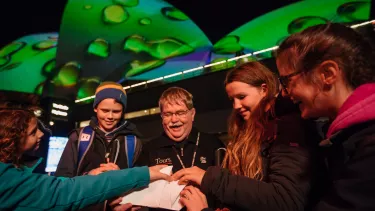5 myths about the Sydney Opera HouseSurprising tales from the icon

The Sydney Opera House is more than just an iconic landmark, it’s a treasure trove of fascinating stories, architectural marvels, and hidden gems that many visitors might overlook.
We sat down with experienced tour guide, Steve McAuley, who has been conducting tours at the Opera House for the past 20 years. He loves the variety of people he gets to meet and of course loves to talk, making it the perfect role.
Go behind the scenes with him as he dispels some myths and shares a few fun facts about the world-famous masterpiece.
The Concert Hall petals are for decoration only

False!
The petals do look nice, but that’s not their main purpose. They’re actually acoustic reflectors, designed to enhance acoustics for both performers and the audience. In total, there are 18 petals constructed out of composite fibreglass. The petals replaced the original hanging reflectors, which were decommissioned in 2020, known affectionately as the ‘doughnuts’.
Animals aren’t allowed in the Opera House

False!
Animals are allowed if they are part of a performance. In the past, we’ve had horses, dogs and birds on stage. During a performance of the opera Boris Godunov in the 1980s, in the Joan Sutherland Theatre, live chickens were on stage as part of the production. A cellist in the orchestra pit got more than they bargained for when one of the chickens fell onto their head. Since then a net has been installed above the orchestra pit in case of falling objects (or chickens).
Unfortunately, your pet still can’t be your plus-one, but assistance animals trained to assist people with disabilities are welcome.
The Concert Hall Grand Organ is the largest mechanical-action organ in the world
True!
The Concert Hall Grand Organ is indeed the largest mechanical-action organ in the world, consisting of 10, 244 pipes. However, this feat came with a hefty price tag, with the organ costing $1.2 million after the 10 years it took to complete. Tuning is done every two years and takes seven to eight days.
The construction of the Opera House was completely government-funded

False!
Though the government did contribute funds to the construction of the now icon, the majority of the funding came from a successful lottery program. Money was also donated through appeals.
Jørn Utzon designed the entire Opera House

False!
After mounting tensions and conflicts with the New South Wales government, Utzon resigned from the project in 1966. Australian architect, Peter Hall, was brought in to complete the interiors, building upon Utzon's original designs as part of a consortium of architects appointed by the government. In 1999, we invited Utzon to develop design principles for the Opera House, ensuring future changes to the building would form with his vision in mind. He then designed the intimate and beautiful Utzon Room, the only interior space entirely realised to his specifications.
If you enjoyed reading these facts, you could learn even more on one of our many tours.